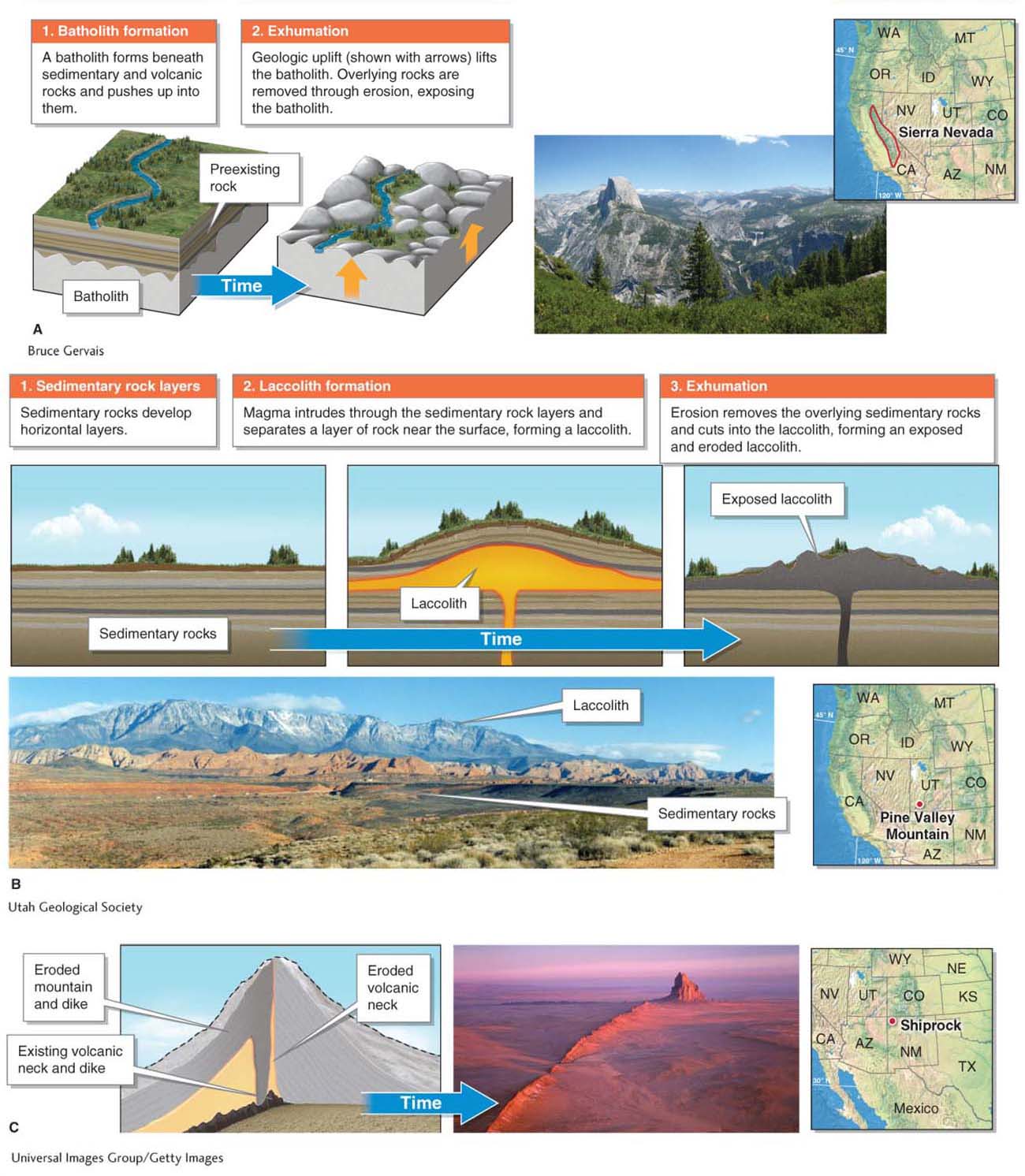13.2 Cooling the Inferno: Igneous Rocks
Describe the different types of igneous rocks and where they form.
Magma and lava are molten materials that originate from either the asthenosphere or the lithospheric mantle. Indeed, the word igneous is derived from the Latin word ignis, which means “fire.”
As you might recall from Section 11.3, the asthenosphere is not in a molten state. Under surface conditions, it would be hot enough to melt, but because of the great pressures it is under, it does not melt. Instead, it is composed of solid rock that slowly deforms and flows. Where, then, does the magma that cools to form igneous rocks come from?
How Do Rocks Melt?
The asthenosphere melts in two settings: where pressure on it is reduced or where water is mixed with it. Decompression melting of the asthenosphere plays a prominent role in the creation of new crust. Decompression melting is the melting of hot mantle material into magma as a result of pressure changes. It occurs as mantle material is brought to a shallow depth in the lithosphere, where the pressure on it decreases enough to allow it to melt. Decompression melting occurs in three tectonic settings: at mid-
decompression melting
The melting of hot mantle material into magma as a result of changes in pressure, which lower the melting point of the rock; occurs as mantle material rises to a shallow depth in the lithosphere.
Mantle material also melts into magma in subduction zones. Flux melting is the process by which subducted water causes mantle material to melt by lowering its melting point.
flux melting
The process by which subducted water lowers the melting point of mantle material and causes it to melt.
Decompression melting and flux melting both result in the production of magma, which contributes to building the crust when it cools and hardens into new igneous rock. Figure 13.7 on the facing page summarizes the tectonic settings in which melting of mantle material into magma occurs (see Sections 12.3 and 12.4 for further details about these tectonic settings).

Once magma forms, it rises into the crust because it is less dense and more buoyant than the lithospheric mantle. Magma may cool either within the crust or on the crust’s surface. Rock that has cooled from lava on the crust’s surface is called extrusive igneous rock (or volcanic rock). Intrusive igneous rock cools from magma underground.
extrusive igneous rock
(or volcanic rock) Rock that has cooled from lava on the crust’s surface.
intrusive igneous rock
Rock that has cooled from magma below the crust’s surface.
Igneous Rock Formations
As magma moves upward through the surrounding rock (called country rock) and solidifies, several types of features may form, including batholiths, plutons, sills, dikes, and laccoliths (Figure 13.8). A batholith is a body of intrusive igneous rock hundreds of kilometers in extent and formed by the movement and fusion of numerous plutons. A pluton, like a batholith, is a dome-

batholith
A body of intrusive igneous rock hundreds of kilometers in extent and formed by the movement and fusion of numerous plutons.
pluton
A dome-
sill
A horizontal sheet of igneous rock that was injected between layers of preexisting rock.
dike
A sheetlike vertical igneous rock formation.
laccolith
A shallow, dome-
Intrusive igneous rock formations are hidden beneath Earth’s surface until they are exposed by exhumation: the removal of overlying rock and sediment to expose deeper rocks at the surface. This process takes millions of years and requires geologic uplift that exposes rocks to erosive forces. Figure 13.9 illustrates the exhumation of a batholith, a laccolith, and a dike in the western United States.

exhumation
The removal of overlying rock and sediment to expose deeper rocks at the surface.
Igneous Rock Categories
The presence (or absence) of crystals and the resulting rock texture reveal much about the conditions under which an igneous rock formed. Magma deep within the crust cools slowly, over decades to millions of years, because the rocks that surround the magma insulate it and slow its heat loss. This long span of time gives mineral crystals time to develop as the magma solidifies into rock. These slowly cooled rocks often have visible crystals, which may be up to several centimeters across, and a rough texture. Such coarse-
Igneous rocks that cool more quickly closer to the surface have smaller crystals and are called aphanitic rocks. Their crystals cannot be seen without the aid of magnification.
In a third category, glassy rocks have no orderly crystalline arrangement of atoms because they cool rapidly at the surface. When a glassy rock is broken, the fresh surface often shines and reflects light just as glass does (see Figure 13.2B).
Plutons and batholiths (see Figure 13.8) cool slowly and are usually composed of phaneritic rock such as granite or diorite. Laccoliths and dikes, on the other hand, cool more rapidly nearer the surface and are typically composed of aphanitic rocks, such as rhyolite or andesite. Because lava cools at the surface very quickly, it may be composed of glassy rocks, such as obsidian or pumice.
The silica content of rocks, along with rock texture, is used to distinguish igneous rock categories (Figure 13.10). The amount of silica in magma depends largely on the amount of country rock melted and incorporated into the magma as it rises through the crust. Felsic igneous rocks (also called granitic rocks; see Section 11.3) are composed of about 70% silica. They are light in color and contain high concentrations of silica, aluminum, potassium, and sodium. Mafic igneous rocks (also called basaltic rocks), in contrast, contain only about 50% silica. Mafic rocks are relatively high in magnesium, iron, and olivine.

